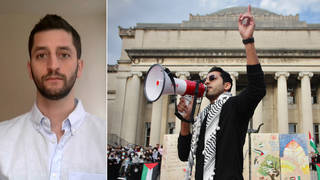
Topics
Guests
- Claire Healyfreelance journalist and a copy aide for The Washington Post.
- Nicole Dungcainvestigative reporter at The Washington Post and president of the Asian American Journalists Association.
The Smithsonian has formed a task force to address the massive collection of human remains held by its museums, which includes 255 human brains that were removed primarily from dead Black and Indigenous people, as well as other people of color, without the consent or knowledge of their families. The so-called racial brain collection was revealed by a Washington Post investigation. It was mostly collected in the first half of the 20th century at the behest of Ales Hrdlicka, a racist anthropologist who was trying to scientifically prove the superiority of white people. We speak with reporters Nicole Dungca and Claire Healy about the series and what they found. Dungca is also president of the Asian American Journalists Association.
Transcript
AMY GOODMAN: We end today’s looking at a major investigation by The Washington Post that revealed the Smithsonian Institution holds a so-called racial brain collection that contains 255 brains gathered in the first half of the 20th century. Much of it was collected at the behest of a racist anthropologist who was trying to scientifically prove the superiority of white people. An investigation by The Washington Post found most of the brains in the Smithsonian collection were removed from dead Black and Indigenous people and other people of color, often taken without consent from their families.
In a moment, we’ll be joined by the two reporters behind this investigation, Nicole Dungca and Claire Healy. But we begin with an excerpt of a video produced by The Washington Post.
NARRATOR: In a cemetery in St. Louis, at least six Filipinos are buried. They died at the 1904 World’s Fair. Janna Añonuevo Langholz started searching for their graves in 2021, after reading about them in archival newspapers.
JANNA AÑONUEVO LANGHOLZ: Well, I think they deserve to be remembered.
CLAIRE HEALY: This whole investigation began in February 2022, when I came across Janna’s Instagram. And I was going to write about her work to find the places that these people were buried. And then she shared a record with me that said four of those people had their brains removed and taken to the Smithsonian.
NICOLE DUNGCA: Once I heard about the Filipino aspect of the story, I got really interested in working with Claire on this.
NARRATOR: Langholz’s discovery would inspire a year-long investigation into the Smithsonian’s collections of human remains.
JANNA AÑONUEVO LANGHOLZ: I had already been researching Filipinos that were part of this exhibit, like put on exhibition, who had died at the 1904 World’s Fair. And I came across a catalog online from the Smithsonian. They had listings of things that they had acquired from St. Louis either during or after the fair.
CLAIRE HEALY: And then I asked the Smithsonian, “How many brains do you have, and why?” And they sent me a spreadsheet of all the brains that they have, with locality and what’s called an accession number. I went to the Smithsonian Institution Archives and took each of these numbers and got the original accession cards.
NICOLE DUNGCA: So, these are the cards that are filed away every time a new body part was entered into a collection at the Smithsonian.
CLAIRE HEALY: And we built up a database of those.
NICOLE DUNGCA: There were children in the collection. There were men and women, and then fetuses. Many of them were Indigenous people, other people of color. And many of them didn’t have their identities actually recorded, partly because they were looked at as specimens.
NARRATOR: The Smithsonian currently has 255 human brains in a storage facility in Maryland. Records suggest only four of those brains were collected with consent.
AMY GOODMAN: That was a video report by The Washington Post to accompany its major new investigation revealing the Smithsonian’s “racial brain collection.”
While the Post was reporting on the story, the Smithsonian formed a task force to develop a policy to address the future of human remains held within its museums’ collections. The Smithsonian Secretary Lonnie Bunch said, quote, “At the Smithsonian, we recognize certain collection practices of our past were unethical. What was once standard in the museum field is no longer acceptable. We acknowledge and apologize for the pain our historical practices have caused people, their families and their communities.” Lonnie Bunch is also the former head of the Smithsonian’s National Museum of African American History and Culture.
Joining us now are The Washington Post’s Claire Healy and Nicole Dungca, who is also the president of the Asian American Journalists Association.
We welcome you both to Democracy Now! Claire, why don’t you lay out the scope of this project? And take it from where you were both speaking in this video report.
CLAIRE HEALY: Sure. And thank you for having us.
I mean, to start, we started looking at the brain collection, which, as you said, has 255 brains. And that’s just what they have today. Like, we found evidence that they had 268, overall, and some were cremated, and four were repatriated. But that’s just a fraction of what they actually have in human remains total. They have 30,700 sets of human remains. And to give you a sense of what that means, each of those numbers is a set of human remains, not an individual, and so the number of people who are in this collection is actually higher than that 30,000.
AMY GOODMAN: So, talk —
CLAIRE HEALY: And the 30,000 comes from 80 countries, at least, around the world.
AMY GOODMAN: All right. Name the anthropologist. Talk about his motivations and where he went all over the world to gather these skulls, overwhelmingly not given by families, not given with consent.
CLAIRE HEALY: Sure. Aleš Hrdlička was the head curator of the Division of Physical Anthropology at the Smithsonian. And when he started at the Smithsonian in 1903, he set out creating a massive network that would collect these remains on his behalf. And so, he would send people to South Africa, to the Philippines to gather remains for him and send them back to the Smithsonian.
And he believed in white superiority. And so, when he was collecting these remains, he wanted to research race and the physical differences that he saw between races. But he was also looking into human origins and the origins of people in the Americas, and so 15,000 of these remains are estimated to be Native American. And he was looking at the origins of people in the Americas, but also all of his studies would come consistently back to looking at race.
AMY GOODMAN: And you talk about how he’s not even referring to his own research as he tries to lay out the basis of his theory of white superiority. He was just spouting the standard eugenics line at the time.
CLAIRE HEALY: Yes. So, we couldn’t find actual studies he did on these brains. A lot of the studies he put out were — on the brain specifically, he did a study on brain preservatives, but he didn’t put out anything on comparing race in the way that he said he wanted to. But he would still answer letters, he would still tell newspapers, that, you know, white brains show some superiority to Black brains, but he wouldn’t reference any studies he did. And as far as we can tell, he didn’t do those studies.
AMY GOODMAN: I want to bring Nicole Dungca into this conversation, the reporter on this incredible series, on this incredible investigation. You’re also president of the Asian American Journalists Association, and you’re a Filipina American. Talk about the Filipino brains in this collection and how you got involved with this story.
NICOLE DUNGCA: Yeah, thank you so much for having me.
As we said in that video, you know, when I heard about the Filipinos involved in this collection, I immediately knew that we needed to make this a big story. And that’s because so much of the history between the Philippines and the U.S., many people don’t know.
So, actually, four of these brains had actually come from Filipinos who had been brought to the 1904 World’s Fair in St. Louis. And there, there had been what was essentially a human zoo, a living museum exhibit, where people would flock to St. Louis and see how Indigenous Filipinos and other Filipinos were living. They lived in mock villages, and they would do their daily chores. And people would say these people were primitive or that they were savages. And fair officials actually pressured the Igorot people — that is a term that broadly talks about Indigenous Filipinos who live in the Cordillera region of Luzon — they would pressure these Indigenous Filipinos to eat dogs, even though that happened very rarely back home. And so that exacerbated a stereotype that lingers to this day.
And so, what we actually found is that some of these Filipinos died while they were at the fair or on the way here from the Philippines. And what Aleš Hrdlička knew was that he could go there and actually take some of their brains. And so, what we found is that Hrdlička went to St. Louis in 1904, and he autopsied two Filipinos, and two other Filipinos had their brains sent to him later. But one of them was likely a woman named Maura. And we created an illustrated narrative about her life and her death with illustrations from a Philippine-based artist named Ren Galeno, because we wanted to really show that fair from the perspective of the Filipinos. We dug deep into newspaper archives, and we saw, you know, many articles where they were referring to them as “savages.” They were talking about their customs as if they were very strange. And we really wanted to create something that would show the perspectives of the Filipinos, because so many of those perspectives had gotten lost.
AMY GOODMAN: And just to be clear, the U.S. had occupied the Philippines from 1898 for what? The next half-century, until 1946.
NICOLE DUNGCA: Yes. And so, I think, actually, the previous segments really talked about being able to teach people the history, some of the dark chapters of the U.S. history. And a lot of people don’t know that the Philippines was a territory and that this was something that really affected how people saw Filipinos. And, actually, William Howard Taft was using the fair basically to show that the U.S. was good for the Philippines. And that was partly why they were bringing these Indigenous Filipinos. They were saying, “Look how we can help them. Look how they are primitive.”
AMY GOODMAN: Can you tell us, Claire, about Mary Sara, her family Sámi, Indigenous to areas that include northern Scandinavia?
CLAIRE HEALY: Yes. So, Mary Sara was an 18-year-old Sámi woman from Alaska, and she died in Seattle in 1933 of tuberculosis. She had gone to Seattle with her mother for her mother to get cataract surgery, and the doctor who was doing the cataract surgery on her mother then took her brain and sent it to the Smithsonian. And so, he sent — on the day that she died, he sent a telegram to Aleš Hrdlička saying, “If you want a Sámi brain, I can get one for you today.” And so, when we reached out to her first cousin in Alaska, she had no idea that this had happened.
AMY GOODMAN: And so, let’s talk about what’s going to happen now. I just read a quote from the head of the Smithsonian. He, Lonnie Bunch, was the founding director of the Smithsonian’s National Museum of African American History and Culture and then became the head of the whole Smithsonian. He’s saying this is unethical. Talk about how the Smithsonian has responded over this year and what they have set up.
CLAIRE HEALY: So, as you noted, he did apologize for how these remains were collected in the past. And he has put together a task force, that has already met three times, to try to look at these human remains and how to return them and how to move forward. He said that he is going to look to the task force to decide that best way of moving forward, whether that’s contacting individual families or, as he suggested, doing some sort of mass grave, is what he said, in Arlington Cemetery. And so, he’s going to look at what the task force wants him to do. And the Smithsonian has also reached out to the Embassy of the Philippines to repatriate the Filipino remains, months after we started reporting. And so, conversations are underway to look into repatriating those remains.
AMY GOODMAN: Nicole Dungca, where are the remains being held now? Are medical professionals able to access this? And also, the fact that this is global — we’re not just talking about skulls and brains from the United States — and what this means, how the international community has responded?
NICOLE DUNGCA: They’re being held right now in the Museum Support Center of the Smithsonian Institution. And that’s in Suitland, Maryland. And actually, at the beginning of the year, Lonnie Bunch III, the secretary of the Smithsonian, restricted access to human remains. But what we do know is that there is the ability to be researching some of these remains if two top Smithsonian officials sign off on this. There are still anthropologists who would be able to access this, but they are creating policies that will be able to say this is what you can do in terms of collecting human remains, it has to be consensual, or this is the kind of research that you will be able to do.
AMY GOODMAN: And, Claire Healy, can you talk about the significance of the largest group, Black people, the skulls and fetuses of Black people, how they were classified, which makes it more difficult to repatriate them?
CLAIRE HEALY: Right. So, the only law in place that the Smithsonian is under is the NMAI Act, and this requires the Smithsonian to send out inventories of its Native American remains to federally recognized tribes. And so, that doesn’t cover other populations and demographics within this collection, and it doesn’t cover Black Americans. And so, a lot of the Black Americans whose remains are in this collection, their families would have no idea, and the Smithsonian isn’t obligated to reach out to any of them or to even release publicly an inventory.
And so, we don’t really have a sense of how they’re going to move forward in informing families, in looking into how to address those remains. But we also know that Black Americans was a population that Hrdlička specifically targeted. He talks about that in his writings and in his manual in 1904 that he puts out in looking for human remains. And so, as we note in the article, the largest racial group in the United States that had brains taken was Black Americans. And it’s unclear what the Smithsonian will do about that.
AMY GOODMAN: Well, we’ll continue to follow this story, as I’m sure both of you will. Claire Healy and Nicole Dungca of The Washington Post. We will link to your remarkable investigative series, “Revealing the Smithsonian’s 'Racial Brain Collection.'”
That does it for our show. Democracy Now! produced with Mike Burke, Renée Feltz, Deena Guzder, Messiah Rhodes, Nermeen Shaikh, María Taracena, Tami Woronoff, Charina Nadura, Sam Alcoff, Tey-Marie Astudillo, John Hamilton, Robby Karran, Hany Massoud, Sonyi Lopez. Our executive director is Julie Crosby. Special thanks to Becca Staley, Jon Randolph, Paul Powell, Mike Di Filippo, Miguel Nogueira, Hugh Gran, Denis Moynihan. I’m Amy Goodman. Thanks so much for joining us.













Media Options